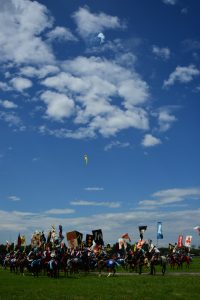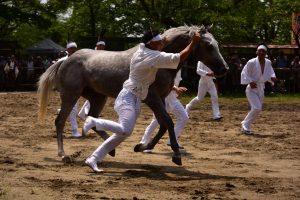This piece is part of the JAWS online series of Reflections from Tōhoku.
How have the residents of the Hamadōri coastal area of Fukushima normalized their daily lives after the 3.11 earthquake, tsunami, and nuclear disaster? I consider this by examining an “intangible cultural asset,” an annual traditional ceremony called the Soma Nomaoi Cavalry Festival, which has been held in the area for close to a millennium.

Since 3.11, Japan’s northeast coast Fukushima residents have had their normal daily lives transformed, and suffering of all types has been rampant, including mental health problems, social upheaval, and financial distress. According to the Fukushima Minyū newspaper (2011) and Makita (2019), more than four thousand people immediately died in Fukushima on March 11, 2011. Half of the total number of victims came from the Hamadōri coast, the highest percentage in the area. Furthermore, because of the nuclear plant meltdown, 164,865 residents of this area had to eventually be evacuated by 2012 (the peak evacuation period). About 20% of those people are still unable to return to their hometowns today.

But even though the nuclear disaster killed so many family members—and with so many people in temporary shelters—the locals still held the Nomaoi festival on its scheduled days, just four months after 3.11. Eighty-two surviving horses marched a part of the usual scheduled route, though 600 horses is normal (Lifull Home’s Press Editorial Board 2021).
Regardless of setbacks throughout history, including World War II, the local people of the Hamadōri area have maintained this festival for over 700 years. By 2019, the number of participants had returned to almost 400 horses and riders; however, in 2020 the Nomaoi festival faced another obstacle: Covid-19. Although there was a Nomaoi festival in 2020, the officials did not allow an audience and all horse-related activities were cancelled. In 2021, the city added a half-day horse parade (it regularly is a three-day event), though without an audience. But even then, people were enthusiastic about holding the festival, and 89 riders rented horses and participated in a short procession (Kahoku Shimpo 2021).
When informants and I talk about Nomaoi, people never fail to mention the glorious history of the event that began in 1323 AD as an annual military training exercise. After that, it became a ceremony directed by the Soma clan until the end of the Tokugawa Period. When the Tokugawa united Japan after a century of civil war, in order to avoid the elimination of the Nomaoi event, the Soma announced that its purpose was now to foster samurai moral values (bushi-do), rather than training for battle per se. Facing the Tokugawa government collapse and the possible Nomaoi elimination, Soma people refocused the theme onto Shintoism, stressing one part of the event, the Nomagake. Here, purified horsemen wearing white Shinto loincloths try to catch a wild horse with their bare hands, which they would then ritually purify, and keep at the Soma main Shrine to be the guardian spirit for the next year. In 1978, Nomaoi became officially designated a National Intangible Cultural Heritage.



Soma History: Identity, Economics, and Social Reorganization in a Crisis


The long history of the Soma clan and the Nomaoi event has been fostering a positive image among the residents, constructing a positive local identity and a furusato (hometown) feeling. For example, while I was talking to a city hall worker who left Soma to pursue higher education, he told me that he is not a horseback rider and had not intended to ride at Nomaoi. But when he visited his parents in Soma during his school’s summer break, he heard people practicing on a conch shell. That sound, and hearing the clap of the horse’s hooves all over the town, made him decide to return to the city after he graduated. In addition, the Nomaoi helps build solidarity among people who are not able to return to their hometowns, or who have sometimes been ostracized at work, or bullied at school, as radiation carriers in their new evacuation locales (cf. Aoki 2018, Tsujiuchi 2018).
Furthermore, the local towns and cities are working hard to attract tourists, using the Nomaoi horse festival and other horse related activities, to bring people to the Hamadōri coast. Even prior to 3.11, when young people went to study in colleges and universities in large cities, they did not always come back to the smaller local cities of the Hamadōri area. However, after 3.11, more and more young people are leaving to look for a safe place to raise their families. City officials are helping the Nomaoi Association, but their purpose is to attract tourists from all over Japan and overseas, and to revitalize local businesses. This also has the added benefit of demonstrating that the area is now safe to visit and live in and that their fish and agricultural crops are safe to eat after the 3.11 radiation problem. The government had to prohibit fishing in the ocean nearby Fukushima, but since 2018 fishermen have been allowed to fish. And yet because of an alleged radiation threat, many people are still cautious. Local farmers are growing their crops while checking the becquerel-levels of radiation (as seen in the picture below). At the same time, they complain that their crops are actually much safer than crops from other places where people are not checking radiation levels. Yet because of the stigma, local fisheries and farms have been facing difficult times.

An Enactment for Individuals and Reenactment for the Group
How does the Nomaoi festival directly influence the local residents and participants, most of whom are living in politically and economically difficult times? The people of Soma probably know their local history far better than people in other areas of the country. For example, participants in the Nomaoi festival study the history of the Soma clan and pass this heritage on to the next generations. Also, for at least two months prior to the event, riders and horses must train rather intensively. This deeply affects the emotions of the participants. Some even begin to take on the mannerisms and attitudes of a samurai going into battle, just like their ancestors of yore did. Some in the cavalry units even change the style of their language around this training period. The two-month preparatory period before the actual event, then, is something of a liminal period, where participants transform themselves from their everyday lives into samurai warriors who glorify the clan, before becoming civilians again after the guardian horse-spirit is selected.
Newcomers usually need a recommendation from some locals in order to participate in Nomaoi, and they have to be approved by the Nomaoi Association members. One of my informants, a medical doctor, moved to the city of Minami Soma after 3.11 in order to take care of radiation patients. In his daily life, he struggles with the shortage of physicians in the area. But after getting to know the locals better, he decided he wanted to participate in the event as well. After going through the vetting process, he became an official rider. He told me of his experience on the morning of the first day of the festival when he will leave with a group of riders on horseback to go to the gathering place. When they pass by the local residents, people come outside saying “Thank you” very devoutly, and pray for their safe return. He feels like he is a samurai of old, who is just about to go into battle, and he forgets about the daily struggles of saving patients while coping with the shortage of physicians in the area. During the Nomaoi period, riders become someone else – a samurai of the area’s 700 years of glory and pride. The positive physiological and psychological effects of a reenactment might be an important reason for holding the Nomaoi event – for both riders and the whole community – during the hardships occurring almost daily, immediately after 3.11 and continuing until now.
The Significance of Nomaoi for Local people
The Nomaoi, being a folk event, is a cultural asset different from other cultural objects such as statues, paintings, and buildings. This is because it is created and recreated by the whole local community each time they perform it. In this sense, intangible cultural heritages are more arbitrary and flexible than tangible cultural assets. Intangible cultural heritages, like Kabuki plays and Noh dramas, have iemoto (masters of particular “schools”) and each iemoto has been teaching in the same strict way from generation to generation, thus, keeping the art “proper” and traditional. This results in a rather static art. In contrast, the Nomaoi event has changed its significance, going from an army training exercise, to a samurai ceremony, to a Shinto religious rite, to today’s community folk festival and historical commemoration. The people recreate the event to fit the needs each time they perform it. Each time when they hold Nomaoi its significance becomes reinvented, along with the social needs of the time.
Throughout its long history, when a crisis occurred and it appeared that they might lose the Nomaoi event, the people redefined and reinvented it, keeping the event’s strong sense of who they are, and maintaining the furusato feeling. Looking at this festival, we see that it is a vital source of local identity and a resource for how residents and evacuees might find inspiration to reconnect to each other and revitalize their community – especially in the face of external stigmatization and other social challenges. The Nomaoi festival has helped normalize the daily lives of the people of the Hamadōri coast of Fukushima post 3.11.
NOBUKO ADACHI is professor of anthropology at Illinois State University in the United States. She is an author of Ethnic Capital in a Japanese Brazilian Commune: Children of Nature (2017) as well as one of the authors of Language, Culture, and Society (7th ed., 2017). She conducted her Fukushima fieldwork in 2019 on a Research Fellowship Program grant from the Japan Foundation.
References
Abe, T. (2014) Nomaoi o ikiru, Minami Soma o ikiru [Living the Nomaoi Festival, Living in Minami Soma]. Tokyo: East Pres Ltd.
Aoki, M. (2018) Chizu kara Kesareru Machi: “3.11-go no “Ittewaikenai Shinjitsu” [The Town Deleted from the Map: A Post-3.11 Truth We Should Not Mention]. Tokyo: Kodansha Gendai Shinsho.
Fukushima Minyū Shimbun. (2011) “Fukushima-ken nai 4147-nin Gisei Shinsai to Tsunami, Doshasaigai-nado” (The 4147 Victims of the Earthquake, Tsunami, and Mudslide in Fukushima Prefecture ) (March 1, 2021, https://www.minyunet.com/news/sinsai/serial/10/01/FM20210301-590385.php) [Accessed Sept. 21, 2021].
Haramachi-shi-shi Editorial Board. (2004) Haramachi-shi-shi Vol. 10: Nomaoi [The History of Haramachi: Nomaoi Vol. 10]. Haramachi-shi, Fukushima, Japan: Haramachi-shi.
Hashimoto, H. (2016) Shinsai to Geinō: Chiiki Saisei no Gendōryoku [Natural Disaster and Traditional Art Performances: The Energy of Local Revitalization]. Tokyo: Otemon Gakuin Daigaku Shuppankai.
Kahoku Shimpo. 2021. July 10, 2021. Online News. https://kahoku.news/articles/20210709khn000051.html. [Accessed Oct. 12, 2021].
Koyama, R. and Komatsu, T. eds. (2013) No no Saisē to Shoku no Anzen: Genpatsu-jiko to Fukushima no 2-nen [Reestablishing Farming and Food Safety, 2 Years after the Fukushima Nuclear Powerplant Accident]. Tokyo: Shin-Nihon Shuppansha.
Lifull Home’s Press Editorial Board. (2021) “‘Soma Nomaoi’ Heiwa to Han’ei, Fukkō e no Negai: Sen-nen amari no Rekishiaru Matsuri no Dentō o Tsunagu-tameni” (The Soma Nomaoi Festival and the Hope of Peace, Prosperity, and Recovering: The Course of an Almost Thousand Year Old Traditional Festival). https://www.homes.co.jp/cont/press/buy/buy_00617. [Accessed Oct. 15, 2021].
Makita, T. (2019) “Arekara 8-nen Hisaichi no Jinkō Hisai Mae-kara 8.6-man-nin Gen, Genpatsu Higai no Fukushia wa Zentai de 17-man-nin Gen” (Eight Years Later: The Center of the Disaster lost 86,000 People and the Fukushima Radiation area, Lost 170,000 People) https://www.rbayakyu.jp/rbay-kodawari/item/4568-8-6-17 [Access Sep. 25, 2021].
Soma-shi-shi Editorial Board. (2017). Soma-shi-shi Vol. 9. [The History of Soma City]. Soma, Fukushima, Japan: Shin-Nihon Hōki Shuppan Co., Ltd.
Sternsdorff-Cisterna, N. (2020) Food Safety After Fukushima: Scientific Citizenship and The Politics of Risk. Honolulu: University of Hawai’i Press.
Tsujiuchi, T. (2018) “Genpatsu Hinan Ijime to Kōzōteki Bouryoku” Special Edition “Genpatsu Jiko no 7-nen” (Seven Years the Nuclear Accident). Kagaku 88 (3): 265-274.
